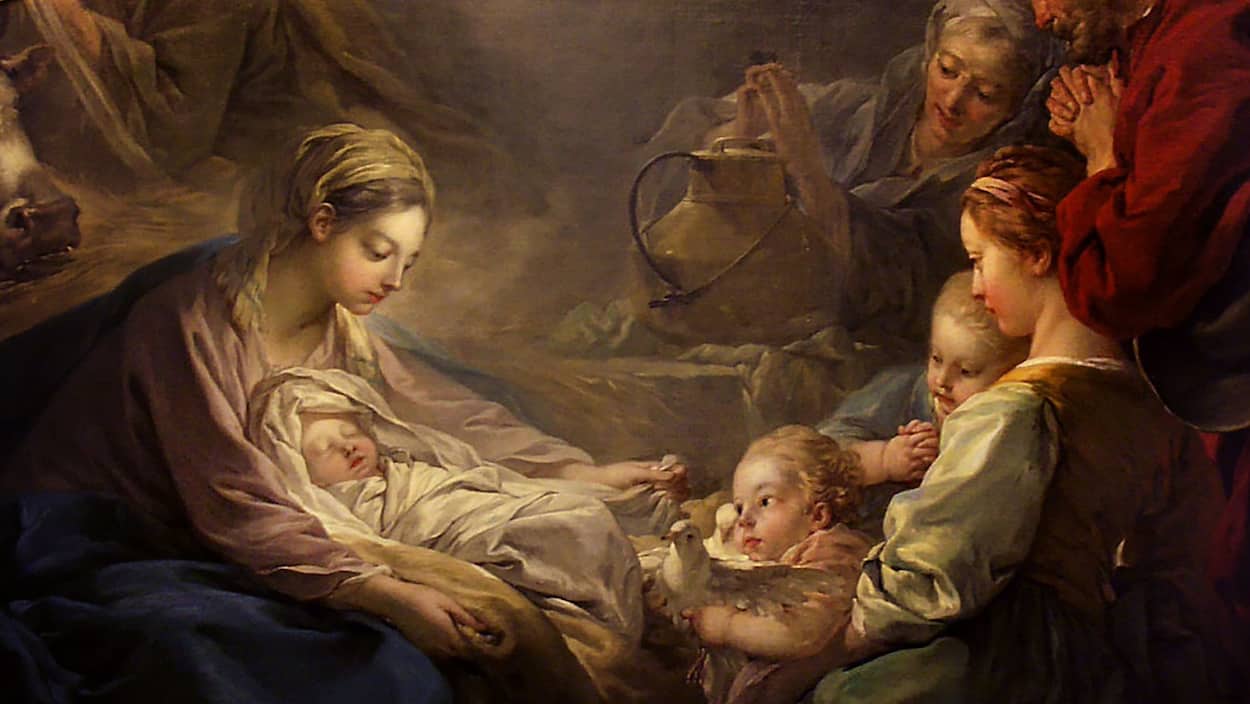In 1223 in the Italian town of Grecio, the crèche was first displayed by the man who, it is said, was most like Jesus—St. Francis of Assisi. From that time until this, over the course of almost eight centuries, Christians have displayed crèches in their churches, homes, and public places. Although some are small and modest, and others large, hand carved works of art, they all serve the same purpose—to remind us of the greatest gift God bestowed on mankind.
Francis’ age differed from the present age in many ways, and in almost all of them we moderns have a distinct advantage. Our knowledge of astronomy, anthropology, biology, chemistry, geography, history, law, medicine, psychology, philosophy, and sociology is immeasurably greater today than in his time. The list of inventions that occurred since the thirteenth century is even longer and includes scientific tools such as the telescope, the microscope, and innumerable other machines and devices, notably those improving communication and travel.
And yet for all the blessings we moderns enjoy, there is one that the people of Francis’ time had in far greater abundance—the blessing of silence.
Silence is still possible today but it no longer surrounds us; we must seek it out away from the noise and bustle of our age. That means turning off radios, televisions, iPads, iPods, computers, and cell phones, and finding a quiet place. And there is no better use for silence than meditation, no better time than during the Christmas season, and no better way than sitting in front of a crèche or calling one to mind.
We can begin by simply focusing on the images before us and allowing the Holy Spirit to bring appropriate thoughts to our minds. If we are not used to meditating, we can begin by guiding our thoughts and being open to the promptings of the Holy Spirit as we proceed.
One approach is to wonder what Mary was thinking and feeling at that time. Was she recalling what Gabriel had said to her nine months earlier—“Greetings, favored one! The Lord is with you . . . Do not be afraid, Mary . . . You will conceive in your womb and bear a son, and you shall name Him Jesus. He will be great and will be called the Son of the Most High”? Was she also remembering her response—“May it be done to me according to your word.” (Luke 1: 26-38)
Was she recalling her subsequent visit to her relative Elizabeth who called her “blessed,” and the response she made:“My soul exalts the Lord, And my spirit has rejoiced in God my Savior. For He has had regard for the humble state of His handmaid; For behold, from this time on all generations will count me blessed.” (Luke 1: 39-48)
What words of love did Mary say to her tiny son as he lay quietly in the manger? Did she sing to him? Repeat her favorite passages from sacred Scripture? Smile at his sweet face, laugh when he gurgled, weep copious tears of joy when the realization of how blessed she was came again to her mind?
Did she wonder what her baby would do as he grew older to manifest his relationship to the Father? Did she wonder in what special way the Father’s love had been with the Son in her womb? Or did she perhaps know the answers to these questions because God had revealed them to her? Surely, during all those months of having the Way, the Truth, the Life, the Savior within her womb, she experienced the love between Father and Son—the Holy Spirit—in a unique way. What inexpressible joy and peace that experience must have brought her!
We can also consider what Mary’s husband Joseph was thinking as he looked at the baby Jesus? Was he recalling the angel’s appearance in a dream and telling him, “Joseph, son of David, do not be afraid to take Mary as your wife; for the Child who has been conceived in her is of the Holy Spirit. She will bear a Son; and you shall call His name Jesus, for He will save His people from their sins”? Was Joseph still in awe of the singular role that his wife Mary had played in bringing salvation to the world? Did he wonder whether he was expected to raise his foster son as other fathers raised their sons or in some different, special way? Was he frightened by the challenge that awaited him? (Matthew 1:20-21)
Another approach is to let our thoughts move beyond the manger scene and wonder, for example, about Jesus’ life as a child. Did he, as a young child, help his mother with her chores? Did he visit Joseph in his workshop? What did Joseph speak of at such times? Virtues such as kindness and love of neighbor? As Jesus grew older, did he work as a carpenter with Joseph? If so, what did they discuss during those many hours together? Scripture? The Commandments? The goodness of God? And what were the Holy Family’s interactions with relatives and neighbors during Jesus’ youth?
We know that when Jesus was 12 he became separated from his parents and spent three days in the temple with the priests, “listening to them and asking them questions” and amazing them with his understanding. (Luke 2: 41-51)
We know too that when his parents scolded him for worrying them, he replied “Why were you searching for me? Didn’t you know I had to be in my Father’s house?” but they “did not understand” his answer. It is unlikely that, over time, they had forgotten the angels’ informing them that Jesus would be the Savior; but we may wonder whether they fully understood what that role would entail.
Scripture is relatively silent about many of these matters but that makes them all the more interesting as subjects of meditation.
After pursuing one or both of these approaches, we can conclude the meditation by saying one of the mysteries of the rosary—Joyful, Luminous, Sorrowful, Glorious—each centered on five events from Jesus’ life. The Joyful mysteries are the obvious choice because they are more closely related to Jesus’ birth. But the Luminous mysteries concern his public life and therefore help expand the focus of our meditation.
Engaging in such a silent meditation will not only deepen our gratitude for the greatest gift God has bestowed on mankind and our admiration of Mary and Joseph for accepting the divine offer to participate. It will also renew and deepen our appreciation of the blessing of silence.
Copyright © 2018 by Vincent Ryan Ruggiero. All rights reserved




